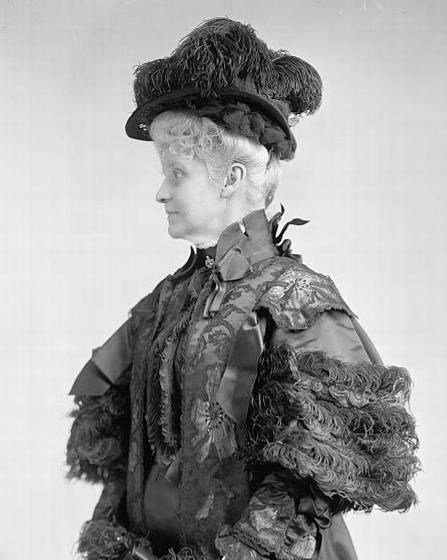Last updated: April 29, 2022
Person
Mary Foote Henderson

Library of Congress
Childhood
Mary Foote was born on July 21, 1842 to Eunice and Elisha Foote. Eunice was a scientist and women's rights campaigner while Elisha was a prominent lawyer and later judge. Eunice Newton Foote had several scientific papers published in the 1800s, and while able to speak at meetings like those of the American Association for the Advancement of Science, she was not allowed to officially 'present' her papers.
Eunice and Elisha were both inventors and held patents. One of the patents involved the creation of a one-piece rubber sole for a shoe that would prevent squeaking.
The family lived together in New York--initially in Seneca Falls and later in Saratoga--until the Civil War. Elisha Henderson moved his family to Washington, DC when he was appointed as Commissioner of the U.S. Patent Office.
Mary attended three schools to achieve her education: Temple Grove Ladies Seminary in Saratoga Springs, NY, Ashgrove Seminary in Albany, NY and a French school in New York City.
Marriage
In 1868, Mary married John B. Henderson. He represented the state of Missouri in the U.S. Senate from 1862 until 1869. Henderson introduced the thirteenth amendment to the Constitution that abolished slavery. His senatorial career ended after he was one of seven Republicans who voted against impeaching Andrew Johnson. He and Mary returned to Missouri.
Mary had long had an interest in art. While in Missouri she helped establish the St. Louis School of Design. She also studied art at Washington University in St. Louis.
In 1877, Mary wrote Practical Cooking and Dinner Giving, a guide to fine entertainment. She followed that book with her 1885, Diet for the Sick, A Treatise on the Values of Food.
The Henderson Fortune
John Henderson purchased large quantities of bonds that had been issued by Missouri counties during the American Civil War. Though purchased for ten cents on the dollar, he made significantly more on them when the courts ordered the counties to pay Henderson their full face values.
John and Mary Henderson returned to Washington from Missouri and bought up dozens of lots outside the northern boundary of the city in the area known as Meridian Hill. At the foot of the hill, the Hendersons built a large brownstone home that became known as “Henderson’s Castle.” Mary Henderson’s interest in the immediate neighborhood, which coincided with the City Beautiful Movement of the early 20th century, ultimately led to the construction of the park.
As a visionary, activist, and health enthusiast, Mary Henderson was determined to make Meridian Hill the gateway to the Nation’s Capital, and poured her energies into accomplishing this goal. She also realized that she could make a great deal of money buying and selling land in the area, and in doing so could control the type of development that would take place there. Mrs. Henderson bought blocks of real estate and had elaborate residences constructed that she sold as embassies. The architect, George Oakley Totten, Jr., designed nearly a dozen buildings on l5th and 16th Streets in the Meridian Hill area to enhance the area for diplomatic uses.
Lobbyist
With a genuine interest in civic improvement, Mrs. Henderson frequently lobbied Congress for various projects to improve and beautify the Meridian Hill area. In 1900, she supported a plan by architect Franklin W. Smith to construct a colossal presidential mansion on Meridian Hill to replace the White House. However, this plan never came to fruition.
In 1911, mostly because of Mary Henderson’s persistent lobbying efforts, Meridian Hill was considered as a possible site for the construction of a memorial to Abraham Lincoln. John Russell Pope, who also designed the Temple of the Scottish Rite and the Lincoln Birthplace memorial, prepared designs for the memorial. Pope proposed a towering memorial recalling the Mausoleum at Halicarnassus that would havestraddled 16th Street, a design rejected by the Commission of Fine Arts because the strength and size of the structure did not fit in with the residential nature of its surroundings Even after the Commission rejected Meridian Hill as a site forte Lincoln Memorial, Mrs. Henderson petitioned Congress in 1912 with another design for the memorial that she had commissioned by Frederick Murphy and W. B. Olmstead. This design too was rejected.
Mrs. Henderson’s most well known crusade was to change the name of 16th Street to “Avenue of the Presidents,” and to line the street with busts of all the Presidents and Vice Presidents of the United States. While she actually succeeded in having legislation passed to change the name of the street in 1913, the Commission of Fine Arts denied her request to construct the busts. One year later, because the name “Avenue of the Presidents” proved to be unpopular, the original l6th Street name was restored.
Other Causes
Mary Henderson was a proponent of women's suffrage, vegetarianism and temperance. She published The Aristocracy of Health in 1904. When John Henderson died in 1913 she poured his entire cellar of wines into the gutter on 16th Street NW.
Meridian Hill Park
When the Commission finally decided to develop Meridian Hill as a public park, The land was purchased from Mary Henderson. Several times, she was successful in persuading Congress to appropriate funds, so that work on the park would continue. Following her death in 1931, the Commission of Fine Arts praised her efforts and her vision of Meridian Hill. A report by the Commission stated: “Persistently she labored during four decades, persuading and convincing Senators and Representatives; single-handed and alone she appeared before committees of Congress to urge approval for the work of development. She won."
